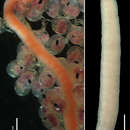Description
provided by Zookeys
External features. In life, holotype (female) about 1 cm long, 0.9 mm wide; pale orange in colour (largely due to alimentary canal), except whitish tip of head (Fig. 1A). Allotype (male) about 5 mm in length, 0.3 mm in width; cream white in colour (Fig. 1B). Living in thin, transparent mucous tube.
Proboscis apparatus. Rhynchodaeum opening to dorsal wall of oesophagus (Fig. 2A). Anterior proboscis chamber 136 µm (unknown in allotype) long by 100 µm (82 µm in allotype) diameter; central stylet basis 48 µm (56 µm in allotype) long by 20 µm (20 µm in allotype) diameter (Figs 2B, 3); central stylet 16 µm (12 µm in allotype) in length (all measured from transverse sections); stylet to basis ratio 0.21–0.33; two accessory stylet pouches each containing two accessory stylets (Fig. 2C). Middle proboscis chamber 80 µm (54 µm in allotype) in diameter. Posterior proboscis chamber 240 µm (unknown in allotype) long by 130 µm (94 µm in allotype) wide. Proboscis almost same length as rhynchocoel, extending posteriorly behind pylorus-intestine junction; musculature of rhynchocoel wall uncertain in light microscopy.
Alimentary canal. Oesophagus opening ventrally at tip of head. Stomach wall containing circular muscle fibres (Fig. 2D).
Glandular system. Vacuolated, basophilic glandular lobes filling much space of precerebral region between body-wall musculature and oesophagus (Fig. 2A), extending post-cerebrally in intestinal region, but gradually less distinct posteriorly (Fig. 4A). Acidophilic submuscular glands scattered among basophilic lobes (Fig. 2A), not arranged in row beneath body-wall musculature.
Excretory system. Flame cells, nephridioducts, and nephridiopores not found.
Nervous system. Dorsal and ventral brain commissures 13 µm (9 µm in allotype) and 10 µm (7 µm in allotype) in thickness, respectively (Fig. 3).
Vascular system. Pair of cephalic vessels meeting above rhynchodaeum, posteriorly passing through cerebral ring (Fig. 3), extending further backward as lateral vessel on each side, situated near lateral nerve cord (Fig. 4A).
Sensory system. No eyes. No cerebral organs. No frontal organ.
Reproductive system. Ovaries more or less regularly interspersed with intestinal lateral diverticula, arranged in row on each side of body; single oviduct from each ovary extending dorsally (Fig. 4B). Single egg string found in the same crab egg mass about 1 cm in length, containing pink eggs (Fig. 5A, B). Takakura’s duct present in male, about 40 µm in diameter (Fig. 4A).
- license
- cc-by-3.0
- copyright
- Hiroshi Kajihara, Armand M. Kuris
- bibliographic citation
- Kajihara H, Kuris A (2013) Ovicides paralithodis (Nemertea, Carcinonemertidae), a new species of symbiotic egg predator of the red king crab Paralithodes camtschaticus (Tilesius, 1815) (Decapoda, Anomura) ZooKeys 258: 1–15
- author
- Hiroshi Kajihara
- author
- Armand M. Kuris
Distribution
provided by Zookeys
In addition to the type locality, the Sea of Okhotsk, off Abashiri, Hokkaido, Japan, Ovicides paralithodis has been reported from Adak, Dutch Harbor, Morshovoi Bay, Pavlof Bay, Kodiak Island, Resurrection Bay, Seward, Cook Inlet and Southeastern Alaska (Barlow Cove, Deadman’s Reach, Gambier Cove, and Pybus Cove, Juneau) by Kuris et al. (1991) as Form 4. The distribution of Ovicides paralithodis, may generally overlap the native range of its host, Paralithodes camtschaticus although it is apparently absent over some large areas such as Bristol Bay and Norton Sound, Alaska. The red king crab was intentionally introduced into the Barents Sea, northern Europe, from the northern Pacific in 1961–1969 (Orlov and Ivanov 1978), and its distribution now extends westward beyond the Kola Peninsula to the Norwegian coast (Falk-Petersen et al. 2011) and north to the Svalbard archipelago (Kirby 2003). Surveys of the introduced Atlantic population of Paralithodes camtschaticus for epifauna and parasites have not recovered any symbiotic egg predator nemerteans (Dvoretsky and Dvoretsky 2010, Falk-Petersen et al. 2011). Apparently the introduced crabs were not infested with these important natural enemies. This lack of infectious natural enemies may contribute to their rapid population growth and geographic expansion in the northeastern Atlantic Ocean (Torchin et al. 2003, Falk-Petersen et al. 2011).
- license
- cc-by-3.0
- copyright
- Hiroshi Kajihara, Armand M. Kuris
- bibliographic citation
- Kajihara H, Kuris A (2013) Ovicides paralithodis (Nemertea, Carcinonemertidae), a new species of symbiotic egg predator of the red king crab Paralithodes camtschaticus (Tilesius, 1815) (Decapoda, Anomura) ZooKeys 258: 1–15
- author
- Hiroshi Kajihara
- author
- Armand M. Kuris

